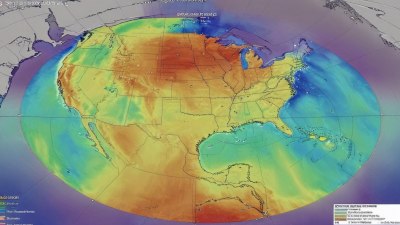How Wind Affects Deep Thoughts More Than Your Therapist
Explore how the natural presence of wind influences deep thinking and mental clarity more effectively than traditional therapy sessions.

Image created with Flux Schnell
The world around us continuously interacts with our minds in subtle yet powerful ways. Among these natural forces, wind plays a unique role in shaping our cognitive and emotional experiences. While therapy is a structured method to improve mental health, the unstructured, organic influence of wind on deep thought processes is often underestimated.
Wind, as a sensory experience, engages multiple faculties simultaneously. The gentle rustle of leaves, the cool brush against the skin, and even the shifting scents carried on air currents create a multisensory stimulus that sets the stage for reflection. Unlike a therapist's office, which can feel clinical and confined, being outdoors and exposed to wind allows the mind to wander freely, unlocking new depths of contemplation.
The physiological effects of wind are significant. The movement of air can lower stress hormones like cortisol, promoting relaxation. This physiological state is conducive to reflective thought and creativity. When stress levels drop, the mind is more flexible, able to connect disparate ideas, and delve into profound considerations that might elude a therapist-guided session constrained by time or agenda.
Moreover, wind's unpredictability mirrors the nature of deep thinking itself: non-linear, unexpected, and dynamic. This natural element disrupts cognitive rigidity, encouraging adaptability and openness. Such openness is often a goal in therapy, where patients are taught to reframe perspectives and embrace new mental frameworks. Wind does this effortlessly by stimulating sensory awareness and moment-to-moment mindfulness.
Therapeutic settings focus on dialogue and introspection facilitated through interaction with a professional. This process, while effective, can be limited by the patient's ability to verbalize thoughts or confront difficult emotions in a structured environment. Wind, however, requires no articulation—it communicates directly through sensation and presence, bypassing the filter of language and allowing access to subconscious insights.
Scientific studies on the impact of natural environments on cognition support the observation that wind and outdoor exposure enhance cognitive flexibility and problem-solving skills. The Attention Restoration Theory posits that nature restores attentional capacities depleted by urban environments and tasks, and the wind plays a critical part in this restorative experience by continuously engaging the senses.
Culturally, many traditions recognize wind as a symbol of change, movement, and inspiration. Poets, philosophers, and spiritual leaders have long alluded to the transformative power of wind on the human psyche. The image of standing in the wind, feeling it sweep past, symbolizes a connection to a larger world and the liberation of thought beyond personal confines.
In contrast, therapy is often context-specific, targeting symptoms and practical outcomes. While it addresses specific mental health needs, it may not foster the spontaneous creative breakthroughs that emerge while being mentally open and physically stimulated by natural forces like wind. Nature therapy or ecotherapy is an emerging field that integrates such natural influences into mental health practices, acknowledging the wind's unique contributions.
Furthermore, wind influences breathing patterns subconsciously. Changes in airflow can deepen inhalation and exhalation cycles, supporting physiological calm and thereby mental tranquility. This automatic regulation contrasts with the effortful breathing exercises taught in therapy, suggesting that nature helps regulate the mind-body connection in an intuitive manner.
The unpredictability and dynamic velocity of wind also stimulate the vestibular system through head movements or subtle balancing adjustments. This stimulation is tied to emotional regulation and cognitive processing. Such physical engagement during contemplative states enhances mental agility and emotional resilience, aspects often developed in therapy but here promoted naturally.
Additionally, the wind shapes environmental sounds, modulating the acoustic backdrop in a way that differs from controlled indoor environments. This complex auditory input can foster a meditative state, supporting long-form rumination and integration of ideas. Therapists rely on dialogue and prompts, but wind-assisted thinking benefits from this passive yet active mental environment.
Research on sensory deprivation and stimulation shows that moderate external stimuli can improve focus and insight. Wind offers a balance—not overwhelming like constant noise, yet present enough to keep sensory faculties alert. This balance is hard to replicate in man-made environments where sensory inputs tend to be either minimal or invasive.
Wind also interacts with visual elements—swaying branches, moving clouds, flickering grass—creating a dynamic visual field that promotes mental 'soft fascination.' This term describes a gently engaging stimulus that does not demand focus but sustains it, offering the perfect milieu for reflection and the birth of novel ideas.
Unlike therapy, which schedules sessions, wind offers an omnipresent, spontaneous resource for deep thought. Anybody can step outside and immediately experience the change in mental state. This accessibility democratizes the benefits, bypassing barriers like cost, stigma, or availability that sometimes restrict therapy.
Nonetheless, the two approaches are not mutually exclusive. Therapists increasingly recommend outdoor sessions or encourage patients to seek nature as complementary to traditional methods. The synergy between professional guidance and natural stimulus like wind can enhance therapeutic outcomes, leveraging both structured support and organic mental shifts.
The psychological concept of flow state, where individuals lose a sense of time while fully immersed in an activity, intertwines with natural environments. Wind can facilitate flow by reducing intrusive thoughts and grounding awareness in the present moment, aiding various creative and intellectual pursuits. Therapists encourage flow to reinforce positive mental health, but the wind helps induce it effortlessly.
From a neurobiological perspective, exposure to fresh air and wind correlates with increased levels of serotonin and endorphins — neurotransmitters associated with happiness and relaxation. This biochemical boost supports mood stabilization and enhanced cognitive function, illustrating another dimension by which wind affects deep thoughts beyond the influence of therapy, which may rely more on cognitive strategies than biochemical modulation.
Furthermore, wind-induced sensory experience can trigger autobiographical memory retrieval, essential for self-understanding often targeted in therapy. The sensory cues of wind might evoke memories tied to past experiences outdoors, facilitating emotional processing in an indirect but profound manner.
The metaphorical aspects of wind also influence mental frameworks. Therapists use metaphor regularly to explore feelings and ideas, but wind’s inherent symbolism as a force of change can unconsciously guide an individual’s internal narrative toward acceptance, release, or transformation.
Moreover, environments with variable wind contribute to resilience-building by habituating individuals to uncertainty and change. This contrasts with therapy, which might isolate fixed problems and solutions. The dynamic nature of wind forces a psychological adjustment to shifting parameters in real time, a valuable skill for mental health.
One cannot overlook the evolutionary perspective: human ancestors have always been exposed to elements like wind, which may have shaped brain functions linked to alertness, problem-solving, and social bonding. Modern life often reduces such exposures, potentially limiting natural cognitive benefits releasable through wind interaction.
In practical terms, incorporating wind-exposure into daily life can involve simple practices like mindful walking in a breezy park, sitting near open windows, or engaging in outdoor hobbies that embrace natural air movements. These activities contrast the sedentary, indoor lifestyle prevalent today and facilitate the organic mental benefits discussed.
Finally, wind nourishes a sense of connectedness - to nature, the environment, and oneself. This connectedness supports psychological well-being, fostering a sense of meaning and purpose often pursued within therapy but naturally cultivated through wind and nature immersion.
In sum, while traditional therapy offers invaluable structure for addressing specific mental health concerns, the experiential and physiological impacts of wind provide an equally powerful, often overlooked avenue for deep thought and mental rejuvenation. Understanding and harnessing this natural force can complement therapeutic practices and enrich the cognitive landscape in profound ways.











